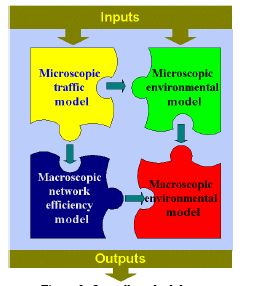
The objective of this research work was to produce an indicative assessment of the impact of selected Driver Assistance Systems on road network efficiency and environmental impact at both a local scale (using microscopic models) and network level (using macroscopic models). A methodology has been developed that integrates several degrees of analysis and facilitates the flow of information from microscopic to macroscopic and traffic to environmental models, as appropriate. A number of parameters have been considered in the determination of the scenarios that were used as the basis for the simulation. The presented model system application suggests that positive impacts may be obtained from the introduction of the considered Driver Assistance systems (Adaptive Cruice Control and Intelligent Speed Adaptation) to traffic efficiency and fuel emissions. Furthermore, results about the safety impact of the introduction of these systems can be indirectly obtained from the traffic efficiency results. The sensitivity of the obtained results to small variations of the inputs has also been tackled.
| ID | pc39 |
| Presentation | |
| Full Text | |
| Tags | intelligent systems, traffic management |







